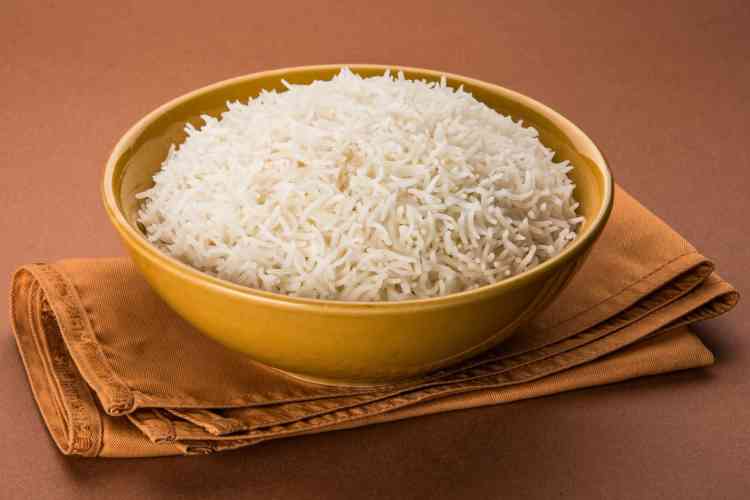Is White Rice Healthy for You?

White rice is a staple food in many cuisines all around the globe but is white rice healthy? A lot of folks will say that it just can’t be compared to its higher-fiber cousin, brown rice, but can it be part of a balanced diet?
In this guide, we’ll explore how the nutritional value of white rice compares to the nutritional value of brown and uncover the diverse health benefits of white rice. So, if you’ve been wondering whether white rice is healthy and if it’s as nutrient-rich as brown rice then we’ve got the answers.
Jump to Section
- Is White Rice Good for You?
- White Rice Nutritional Value
- What Are the Health Benefits of White Rice?
Is White Rice Good for You?
It’s fair to say that white rice enjoys a bit of a mixed reputation. Lots of guidance on the internet and social media advises that white rice is far less nutritious than other types of rice but is that the case? Just how healthy is white rice?
In many countries around the world, white rice is by far the most popular grain and eaten much more frequently than brown rice. So, is white rice healthy? Although it is lower in some nutrients than brown rice, it still has a lot to add to a healthy, balanced diet.
Is White Rice Healthy and How Does It Differ From Brown Rice?
To start answering the question "Is white rice good for you" we first need to dig a little deeper into what sets these two types of rice apart. Both white and brown rice have similar origins but are processed differently. Brown rice doesn’t refer to a particular type of rice; instead the name means any form of rice in its natural, whole grain state.
In this form, a rice grain contains bran (the fibrous outer layer), germ (the nutrient-rich core) and the carbohydrate-heavy endosperm center. White rice is the refined form of brown rice which has had the bran and germ removed, leaving only the starch heavy endosperm. It then undergoes additional processing to give it a longer shelf life and to make it quicker and easier to cook.
Because it has been processed, many people wonder, “How healthy is white rice?” and choose the wholegrain version instead. However, in many countries including the U.S., most white rice is enriched with iron, folic acid, thiamine and niacin, though levels vary by brand.
Both white rice and brown rice are also naturally completely gluten free so are suitable for those with a gluten sensitivity or celiac disease. When served in moderate portions and paired with vegetables, lean protein and healthy fats, white rice is healthy as part of a balanced meal. Steaming or boiling is best, since deep-frying or cooking with excess oil or butter adds calories.

Is Brown Rice Healthier Than White Rice?
White and brown rice have similar calories, but brown rice provides more fiber and slightly more protein and fat because it retains the bran and germ. Brown rice also provides more magnesium, phosphorus and some B vitamins, nutrients concentrated in the bran and germ.
According to the Dietary Guidelines for Americans, 2020-2025, it’s recommended that half of the grains in our diets come from whole grains such as brown rice and whole-wheatmeal bread. These high fiber foods have many health benefits including lowering the risk of developing illnesses such as diabetes and heart disease.
So, what does this mean when figuring out just how healthy white rice is? While brown rice is generally considered healthier due to its higher fiber and nutrient content, white rice can still fit into a balanced diet — especially when combined with whole grains like brown rice to boost fiber. If you prefer white rice, mix in beans or vegetables, or use a half-white, half-brown blend to raise fiber.

Is White Rice Good for Weight Loss?
White rice is often blamed for weight gain, but that isn’t necessarily the case. On its own, white rice doesn’t cause weight gain; regularly eating more calories than you burn does.
White rice is healthy in moderate portions and brown rice may boost fullness with more fiber, but calorie balance and overall eating pattern determine weight loss. It’s also easy to incorporate into delicious recipes, as you’ll discover at healthy online cooking classes.
To make white rice work in a weight-management plan, focus on how much, what you pair it with and how you prepare it:
- Aim for about ½ cup cooked rice per serving.
- Combine rice with lean protein and plenty of nonstarchy vegetables so rice takes up about a quarter of the plate.
- Parboiled or basmati varieties tend to have a lower glycemic index than some other white rices.
- Cooking then cooling rice can modestly increase resistant starch. Reheat safely and keep portions the same.
- Sauces, butter and fried preparations add calories fast. Steaming or boiling keeps it lighter.
- Try a half-and-half mix of white and brown rice, or stir in legumes for extra fiber and protein.

White Rice Nutritional Value
At this point in the article, you’re probably wondering exactly how healthy is white rice and how exactly does it compare to brown rice? The table below details the nutritional composition of 100g of cooked white rice compared with the same serving of brown rice, as outlined by the USDA:
| White Rice | Brown Rice | |
| Calories (kcal) | 129 | 123 |
| Carbohydrates (g) | 27.99 | 25.76 |
| Fiber (g) | 0.4 | 1.0 |
| Sugar (g) | 0.05 | 0.22 |
| Protein (g) | 2.67 | 2.43 |
| Fat (g) | 0.28 | 1.11 |
What Are the Health Benefits of White Rice?
We’ve established that white rice is healthy in controlled portions, here are some reasons why:
Quick Energy Release
One of the main reasons people may wonder, “Is white rice healthy?” is its status as a high glycemic food. The Glycemic Index (GI) is a system which scores foods based on the extent they increase blood sugar. Foods with a low GI score raise blood sugar slower to a lower level while high GI foods raise blood sugar quicker.
As a result of having the bran and germ removed, white rice is characterized as a high GI food. Because it has a higher GI, white rice can provide quick pre-workout energy. Pair it with protein, fat or fiber to help moderate blood sugar.

Fortified With Vitamins
Is brown rice healthier than white rice because of its nutritional content? As mentioned above, brown rice contains more naturally occurring minerals but most white rice is enriched with iron, folic acid, thiamine and niacin. These vitamins and minerals all contribute to good health and support bodily functions including cell production and maintaining healthy skin.

Easy to Digest
Some people with IBS (Irritable Bowel Syndrome) and IBD (Inflammatory Bowel Disease) find lower fiber foods easier to tolerate. In those cases, white rice may be a better-tolerated option than brown rice as it may help to relieve symptoms such as bloating and discomfort.

Naturally Low in Fat and Sodium
White rice is naturally low in fat and sodium, making it a versatile base for balanced, heart-healthy meals. The sodium stays low when cooked without salted water or high-sodium sauces.

Good for Gut Health
As further evidence fueling the debate “Is white rice healthy for you?”, research indexed on PubMed suggests that cooking then cooling white rice can modestly increase its resistant starch content. Resistant starch may support gut health by acting as a prebiotic vs. probiotic, providing fuel for beneficial gut bacteria that aid digestion and overall gut function.

Tips for Adding White Rice to a Healthy Diet
We’ve established that the answer to the question “Is white rice healthy?” is “Yes, in moderation!” But, if you’re wondering how to start eating healthy this year, and maximize your food enjoyment while also working towards your diet and fitness goals, we’ve got a few tips.
Planning to hit the gym and seeking a great breakfast? White rice is healthy as a speedy source of energy and useful before a workout. Combine eggs or tofu with vegetables such as mushrooms, spinach and tomatoes and serve on cooled white rice.
This combination provides fast energy, and cooling the rice ahead of time can add a small amount of resistant starch; a key reason why white rice is a healthy choice. Alternatively you could make a batch of warm and comforting congee rice porridge that’s great with fresh fruit.
Try substituting part of your serving of white rice with colorful wild rice. The flavor of the wild rice contrasts well with white rice and can be used alongside your favorite dishes such as red chili, curry shrimp or other tasty dinner food ideas.
If you’re seeking more inspiration for healthy recipes that feature rice then cooking classes near you have lots to offer. They’ll give you invaluable kitchen skills and teach you how to make a smorgasbord of rice recipes from around the world, from Spanish paella to Japanese sushi.

We’ve gone into detail here to answer the questions “Is white rice healthy?” and “How healthy is white rice?” While white rice is not unhealthy in and of itself, there is lots of evidence to suggest that choosing brown rice instead can be better for overall health.
Although the nutritional profile doesn’t differ significantly between the grains in terms of calories, the increased fiber and vitamins in brown rice can help to balance blood sugar and maintain key body functions.
However, the answer to the question, “Is white rice healthy?” is not a straightforward no. It can be great for those with inflammatory digestive issues who may need to limit the amount of fiber they’re consuming. It also has several other benefits including supporting gut health.
Therefore, it’s not necessary to remove white rice completely from your diet. Moderation and balance with other food groups are key. Additionally, taking simple steps such as adding extra vegetables to your favorite dish can make white rice a healthy and enjoyable part of your everyday diet.
For even more ways to explore your favorite foods, check out other experiences happening on Cozymeal.



FOOD FOR THOUGHT?
Join the conversation.